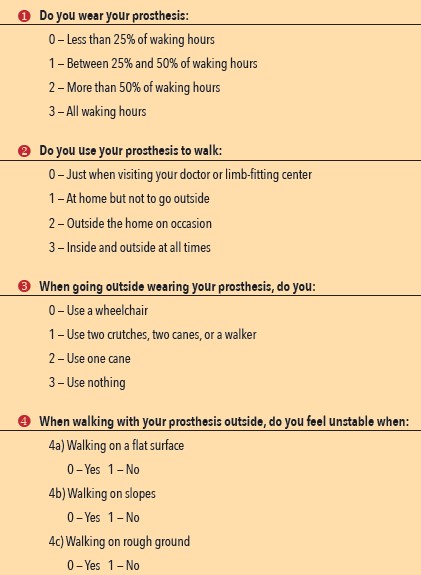Houghton Scale
Introduction[edit | edit source]
The Houghton Scale was developed by a team of British researchers, led by a vascular surgeon named A.D. Houghton, MD. They were out to determine the rate of successful rehabilitation among individuals with lower-limb amputations of vascular etiologies. The scale quantifies functional outcomes among people with lower-limb amputations.
Objective[edit | edit source]
The Houghton scale[1] is a 4-item instrument that accesses prosthetic use in people with lower extremity amputations. It reflects a person’s perception of prosthetic use. It's self-administered and easy to score.
Intended Population[edit | edit source]
The scale is intended for use by individuals with lower limb amputation
Method of Use[edit | edit source]
The first 3 items are scored on a 4-point scale and it attempts to capture prosthetic wearing habits whilst the fourth question has 3 dichotomous (yes/no) items that assess a patient’s comfort level when negotiating different outdoor surfaces. Results are reported as a total score out of 12, with higher scores indicating greater performance and greater comfort.
Evidence[edit | edit source]
Miller et al[2] compared the Houghton Scale with the Prosthesis Evaluation Questionnaire (PEQ) and the Locomotor Capabilities Index of the Prosthetic Profile of the Amputee (PPA) and concluded that Houghton Scale had modest internal consistency, good test retest reliability, and was the only scale tested that could discriminate between people with transfemoral and transtibial amputations.
References[edit | edit source]
- ↑ Houghton AD, Taylor PR, Thurlow S, Rootes E, McColl I. Success rates for rehabilitation of vascular amputees: implications for preoperative assessment and amputation level. Br J Surg 1992;79:753-5
- ↑ Miller WC, Deathe AB, Speechley M. Lower extremity prosthetic mobility: a comparison of 3 self-report scales. Arch Phys Med Rehabil 2001;84:1432-40.







